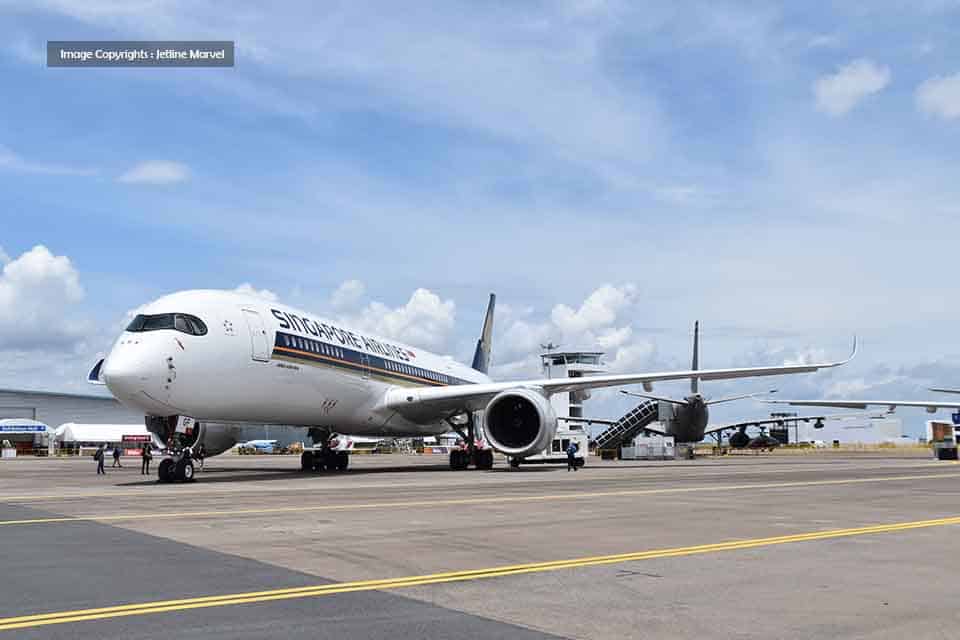Aerospace
Singapore Airlines A380 delivered in 2009 being scrapped at Singapore
A Singapore Airlines Airbus A380 delivered to the airline in 2009, was scrapped at Changi Airport, 10 years after service #A380 #SingaporeAirlines #SIA

The Airbus A380, an engineering marvel, is being laid to rest in a cemetery. As you can see in the pictures, a Singapore Airlines A380 was just scrapped at Changi airport. The superjumbo aircraft’s sad finish
The first A380 registered F-WWOW made its first flight on April 27, 2005, after being unveiled in Toulouse in 2005. The Trent 900 engine was installed in the aircraft. The initial test flight crew compared it to riding a bicycle. The A380’s first customer was Singapore Airlines, which began flying planes in 2007.
The airplane is the direct rival to the Boeing 747, which is no longer in production. However, the A380 was also discontinued due to a decline in market demand.
Over 7.3 million block hours, the global A380 fleet had accomplished more than 800,000 flights without a single fatality or hull loss.
-
Lower seat availability.
The decreased passenger occupancy rate in the aircraft is likely to have an impact. Obviously, airlines must engage in extensive marketing to attract high-end travelers, and due to their size, must operate out of larger airports like London Heathrow, Dubai, and Singapore Changi, which has a direct impact on the cost of passengers’ tickets.
-
The cost of airplane maintenance is high.
Airworthiness authority regulations mandate certain regular checks from authorized aircraft tool shops as the A380 fleet ages. As a result of the larger size and greater number of parts on an aircraft, maintaining it takes more time, which has an adverse effect on the operations of airlines. In 2014, the Emirates conducted its first 3C-check in 55 days. Some airlines will take advantage of extended shop stays to install new interiors. However, a small number of airlines must incur high maintenance costs and operate with interruptions due to extended hanger stays.
-
Shorter life cycle.
As aircraft age, most airlines retire them after 12 to 14 years of service. After that, they can find a second lease on life as freighter versions, which can operate for an additional 15 years. It will eventually be recycled. However, the scenario in the A380 was different.
The only reason the Boeing 747 has survived longer is that its airframe can be used for both passenger and freighter versions of the aircraft, whereas Airbus has no plans for converting any of its aircraft into freighters.
How should I proceed if an aircraft is about to crash?(Opens in a new browser tab)
Since at least June 2005, Airbus has offered the A380F, a cargo variant with a maximum payload capacity of 150 t (330,000 lb) and a range of 5,600 nmi (10,400 km). Compared to the Boeing 747-8F, it would have had a 7% greater payload and a greater range, although it would have cost more to travel.
There was no specific release date, and production was halted until the A380 production lines were stabilized.
Airbus realized their error, and the A350 is now available in a cargo form. The Freighter version of the aircraft was launched in 2022, and it will undoubtedly bring in more customers and expand the services offered by the airlines.
China’s top 3 airlines will purchase nearly 300 Airbus A320neo aircraft.(Opens in a new browser tab)
-
COVID Issues
The biggest impact on airlines is Covid. The majority of airlines ceased operations and grounded numerous aircraft, although doing so for the A380 would be more costly for more airlines as the aircraft’s operating costs and age soared. Airlines’ business has increased over the past year for COVID purposes. Airlines struggle to run the A380, and the CEO of Qatar Airways stated that there are no plans to bring the A380 back. Many airlines have sent their planes to be stored in France and other locations that are only targeted at the lower end of the market.
-
No secondary market value
The airplane has no resale value; numerous airlines attempted to sell it to other carriers but were unsuccessful. who has a big market share but they did not want to operate it once again, just as Emirates did not want to purchase the second aircraft. As Singapore Airlines discontinued operating these four A380 aircraft in 2017, the Dr. Peter Lease Company, who provided Singapore with those aircraft, found it difficult to find a new customer for their A380. When they were unable to locate an operator, they ultimately made the decision to sell each individual part to another airline operator for a price between $30 and $50 million. thus in 2019, the airplane was disassembled.
The explanation cited by Air France for grounding the A380 was that the cabin modifications would cost close to $45 million, Lufthansa would declare them unprofitable, and other airlines with less market share would only fill 30% of the available seats.
Since Emirates owns half of the A380 aircraft built to date, it is one of the few airlines that still have the courage to fly. Due to its strong brand recognition, Emirates has high passenger utilization rates on its A380 aircraft. They regularly upgrade the interior and business and first-class seating, maintaining the passengers’ sense of luxury and adding value to their status and reputation.
Emirates makes shrewd operational decisions. When their Boeing 777 cannot handle the passenger capacity, they place A380 operations there and offer regular service to most major locations across the globe. Recently, it began flying to the most famous airport in south India, Bangalore. They also have an in-house maintenance facility for airplanes, and they manage and run the aircraft expertly. Other airlines are grateful to the Emirates for handling their aircraft maintenance.

Aerospace
India is set to build a central command for the Air Traffic Control system, called ISHAN

India’s air traffic growth has led to increased responsibilities for air traffic control. The Airports Authority of India (AAI) is considering centralizing air traffic control for aircraft, dividing the country into four regions. The goal is to consolidate India’s segmented airspace into a single entity to improve air traffic management (ATM) efficiency, safety, and smoothness.
Recently, the AAI invited expressions of interest to develop a detailed project report for the Indian Single Sky Harmonized Air Traffic Management (ISHAN) initiative in Nagpur. Under this plan, air traffic controllers in Nagpur would handle domestic flights flying above 25,000 feet, eliminating the need for coordination among controllers in different regions.
For domestic regional flights operating above 25,000 feet, control would shift to the central command in Nagpur. This consolidation aims to enhance airline operations, increase flight handling capacity, and reduce congestion and flight times for passengers.
Currently, the AAI provides ATM services over Indian airspace and adjoining oceanic areas, covering over 2.8 million square nautical miles. This airspace is divided into four flight information regions (FIRs) in Delhi, Mumbai, Kolkata, and Chennai, along with a sub-FIR in Guwahati.
FIRs are responsible for providing air traffic services, including weather information, visibility, and search and rescue assistance. The proposed unification under the ISHAN initiative aligns with the projected growth of the aviation industry, which anticipates a doubling of domestic passenger traffic by 2030.
Aerospace
Does AirAsia show interest in Comac aircraft in the future?

Tony Fernandes, CEO of Capital A, operating as AirAsia Group, recently paid a visit to the facilities of COMAC on April 2, 2024, and was thoroughly impressed by what he witnessed.
C919 already securing nearly 1000 orders
COMAC, known for its homegrown aircraft, has launched two promising jets: the ARJ21 and the C919 aircraft. Both aircraft are gaining popularity in the Chinese market, with the C919 already securing nearly 1000 orders from various airlines.
Fernandes expressed his admiration for COMAC’s achievements in aircraft manufacturing, acknowledging the immense challenge it entails. His visit underscored the realization that AirAsia now has a viable third option when it comes to selecting aircraft for its fleet.
During his tour, Fernandes was delighted by the innovation and technology evident in COMAC’s aircraft production and the company’s commitment to long-term partnerships.
He noted that many Western companies have shifted away from prioritizing loyalty and customer service, opting instead for short-term gains and a narrow definition of success.
Last month, COMAC embarked on an international tour, showcasing demonstration flights to neighboring countries, particularly Indonesia and Malaysia. Fernandes believes that the positive impression left by COMAC during his visit opens up new opportunities for collaboration.
Fernandes emphasized COMAC’s remarkable achievements
The shared values of loyalty, customer service, and long-term vision align closely with AirAsia’s ethos, making collaboration with COMAC appealing. With a focus on innovation and excellence, both companies stand to benefit from a partnership grounded in trust and a shared commitment to success.
Indonesia and China have already collaborated in validating and maintaining the airworthiness of the ARJ21 aircraft, indicating a solid foundation for future partnerships.
In his statement, Fernandes emphasized COMAC’s remarkable achievements and genuine desire for long-term partnership, highlighting the absence of ego and a genuine willingness to succeed together. He marveled at COMAC’s fully automated, AI-driven factory, a testament to their dedication to innovation and efficiency.
Fernandes criticized Western firms for prioritizing short-term gains over loyalty, customer service, and long-term strategy, emphasizing the importance of understanding customers’ needs and collaborating to achieve success.
Aerospace
Indigo will soon launch Air Taxi Service in India

InterGlobe Enterprises, the parent brand of IndiGo, is set to revolutionize travel in India with its upcoming air taxi service.
Scheduled for a potential launch in 2026, this innovative venture promises a seamless journey for passengers between two bustling hubs. Delhi and Gurgaon in Haryana. The forthcoming service is projected to revolutionize the daily commute, offering passengers a swift aerial journey covering the distance in a mere 7 minutes.
This remarkable efficiency contrasts starkly with the conventional 90-minute drive, underscoring the immense time-saving potential for commuters. The anticipated fare, ranging from Rs 2,000-3,000, makes this innovative mode of transport not only swift but also remarkably competitive in pricing.
At the heart of this ambitious endeavor lies a strategic partnership with Archer Aviation, a pioneer in electric vertical takeoff and landing (eVTOL) aircraft technology. Under this collaboration, Archer will supply 200 state-of-the-art eVTOL aircraft, representing an investment of US$ 1 billion. These cutting-edge aircraft, capable of accommodating up to four passengers alongside the pilot, epitomize the future of sustainable air travel.
Powered by six battery packs, Archer’s eVTOL aircraft boast rapid charging capabilities, enabling a swift turnaround between flights. With a charging time of just 30-40 minutes, these eco-friendly aircraft ensure minimal downtime, maximizing operational efficiency.
Similar services are anticipated to be introduced by the joint venture in Bengaluru and Mumbai as well. Nevertheless, the service rollout period has not yet been made public by the company. Next year, it is anticipated to get its certification. Following this, the company will start the certification procedure with the Directorate General of Civil Aviation (DGCA).























